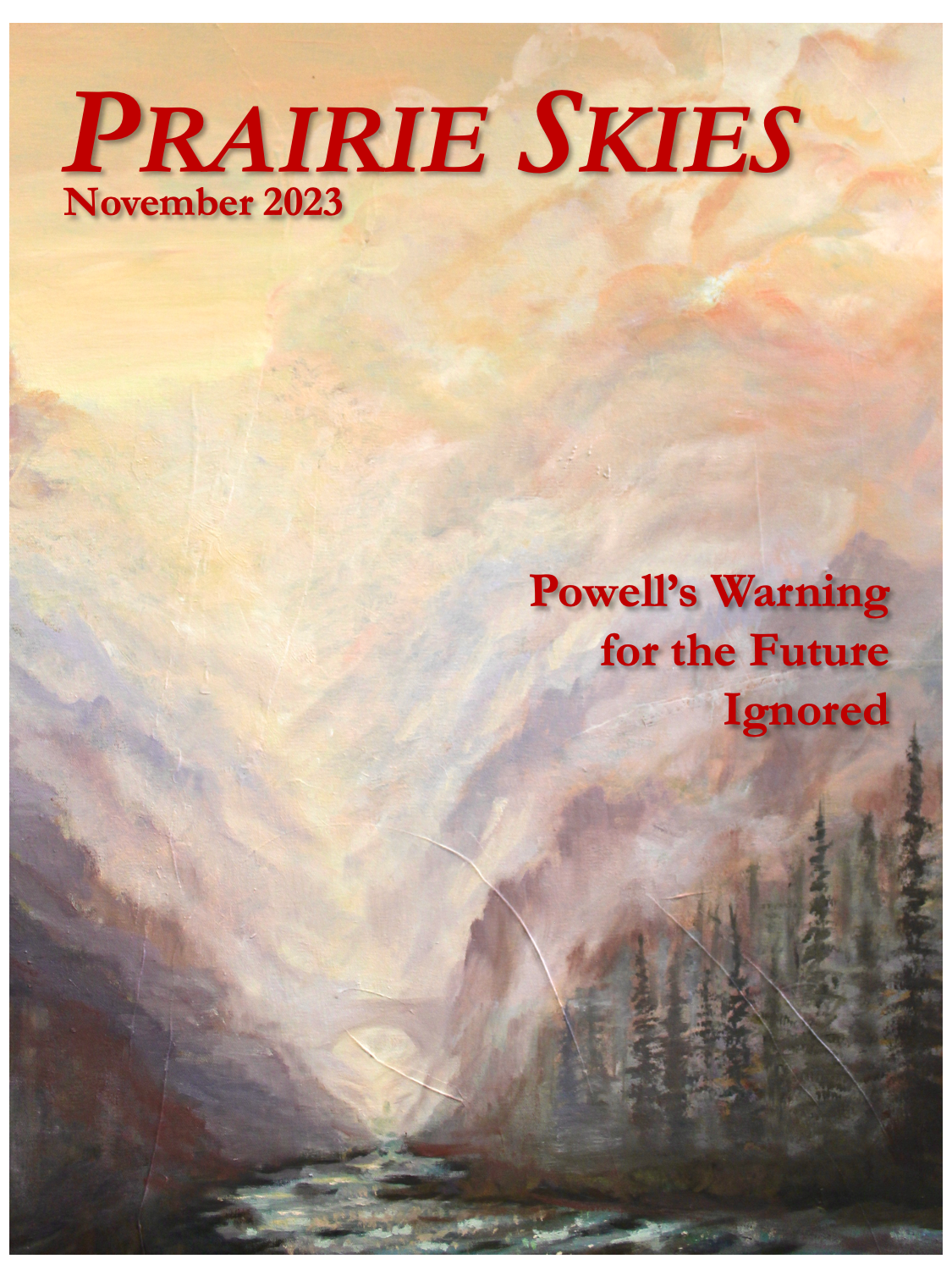Prairie Skies: November 2023
Prairie Skies
A Monthly Journal of Weather & Climate in the Prairie
November 2023; Volume 1, Issue 3
Powell’s Warning for the Future Ignored
Part II in the “Without Water” Series
In a small craft built for the sea, eleven men traveled through perilous waters to observe and document the Colorado River. After the expedition through the Grand Canyon, Powell’s observation became a warning for the future.
John Wesley Powell (1834-1902) foretold problems if humanity did not heed nature’s plea to conserve water. His work and river expeditions provided observations of what could happen well beyond his life for millions of people. Yet, his warnings have been mostly ignored.
Born in 1834, in New York, Powell’s father and mother eventually settled in Boone County, Illinois. As a young man, he studied at Illinois College (now called Wheaton College) and Oberlin College. While studying, he taught for seven years in natural science but never completed a degree in his beloved subject.
In his early twenties, he made several tours of the river systems of the east and Midwest in sections: the Mississippi River (1856), the Ohio River (1857), and the Illinois River to the Des Moines River (1858). In many of his expeditions, he simply rowed his way to a pre-determined destination.
After climbing Long’s Peak in 1868 with six other men, he gathered ten men in 1869 to explore the Colorado River and the Grand Canyon. In May 1869, he entered the river at Green River, Wyoming and continued to the confluence of the Colorado River with ten months of supplies. He, and his team, finished their laborious water trek on August 30, 1869, noting rough, turbulent, chaotic, and perilous waters along the way.
Three men deserted the expedition after three months, and three disappeared just days before the end of the expedition due to unknown reasons; still debated by historians. As a proper scientist would do, Powell retraced his expedition with another team in 1870-71, but included a small group of photographers to record the beauty of the river.
Powell is regarded as a land conservationist who focused on available water to supply the land. He once stated that “the West was no place for large scale agriculture.” Time would test his conclusions: the river’s ability to provide for human consumption, and the food required for human sustainability.
Although Powell proposed an irrigation system based on watershed boundaries near river systems that would reduce disagreements between states requiring water rights, the railroad companies disagreed. The railroad companies lobbied heavily against the proposed legislation in Congress to allow the growth of farmsteads to help feed the nation. Powell lost the venture.
Congress’ reaction was based on the research from Cyrus Thomas, a protégé of the former explorer, Horace Greely, that more farming would increase precipitation of the arid west. Thomas’ idea, “The rains will follow the plow,” was agreed upon, and later discredited after the “Dust Bowl.”
Today, the Colorado River is the only lifeline for the Southwest United States. Exhausted aquifers no longer provide the mass of residents of Phoenix, Flagstaff, or Albuquerque with water for daily use. In fact, many of the smaller communities have been cut off from water facilities supplying those major urban areas, as recently reported in the New York Times.
Beyond Powell’s recommendation, during his lifetime, federal and state legislation created dams along the Colorado River to retain water in reservoirs for water conservation for development and agriculture. Those reservoirs are dwindling to the point that the Colorado River no longer reaches the Gulf of California.
Coupled with a significant warming environment and over irrigation for food production, the Colorado River is unable to provide for the needs of a growing population. Persistent drought and consumer requirements for water have put politicians in overdrive to determine a fix to the water problem of the Southwest.
Powell’s observation, over a century and a half ago, should be a permanent household concern for the future, not only for the Southwest, but for the Midwest.
Rainfall over the Midwestern states continues to be erratic. While the aquifers in the Midwest take centuries to recharge, our rivers will suffer as well with the increase in population of urban centers. The unreliable position of the jet stream, that brings troughs of precipitation, continues to exacerbate sources of surface water. If these surface waters are unable to provide food for the population, we, as a human race, will succumb to disaster on a level of historic proportions.
Powell, until his death in 1902, continued to promote his scientific conclusions about water availability in the west, and his conclusions translate the problems we will see in the Midwest’s future. The questions students ask in my classes, this semester, are tumultuous. They are concerned about the availability of water for their children. They are asking how to conserve. This is extremely good!
“From where is this concern coming?” I ask the students. “We were never informed and thought that there wasn’t a water issue here in the Midwest.” They believed that the Great Lakes would always be there to supply the water needed for the future.
While Powell gave us a warning over a century ago, our water problem in the Midwest is only beginning. We must heed his warning, not just for the west but for us.
Cameron Douglas Craig
Picture of the Moment
The Next Generation

Former “SkyWatch” Forecaster, Nick Patrick (’14), and wife, Alyssa, and daughter, Penelope. Nick is a meteorologist with WICS in Springfield, IL. Photo used with Permission.
Reflection & Connection
USS Moffett, One of Many Forces Against Nature & Oppression
The Atlantic Ocean can be an unforgiving element of nature: storms of great magnitude, unrelenting waves from gale force winds, and a power against humanity. Alternatively, it is serene, with picturesque sunrises and sunsets, giving sailors a moment of reflection. Yet, far below the ocean’s surface, a menacing character of the black abyss lurks in the murky waters of the ocean during war, submarines.
The USS Moffett, a Porter-class destroyer, DD-362, was among hundreds of wartime vessels combating the natural elements and German U-Boats in the Atlantic. Named after Admiral William Adger Moffett (1869-1933), the destroyer was laid down on January 2, 1934, commissioned on August 28, 1936, and served her country on the open seas between 1936 and 1945.
After she had crossed the Equator several times, she hosted one prairie resident, First Class Petty Officer Stanley H. (Red) Robinson, my grandfather. From interviews with him during my time as a history student, Grandfather Robinson oversaw the first fire hold of the USS Moffett. He loved the Moffett. He painted the Moffett, after his time in the war. He even named his first child “Moffett,” my mother.
In the elements and fear of sea wolves, it was his and his buddies’ home; just a thin sheet of iron protecting them from the sea, and the destructive forces of World War II, torpedoes.
Storms from the Midwest eventually make their way to the Atlantic Ocean. Winter storms are particularly harsher than summer storms due to the drastic change between warmer conditions from the Tropics battling the fiercely colder temperatures of the Polar Regions. Waves increase in these conditions, affecting those with a mission to prevail.
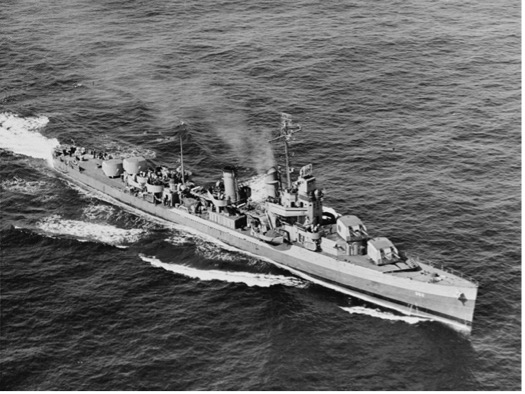
USS Moffett, DD-362, a Porter-class Destroyer that served between 1936 and 1945. She was commissioned on August 28, 1936, decommissioned on November 2, 1945, stricken on January 28, 1947, and sold for scrap on May 16, 1947.
Naval warfare is particularly treacherous due to the atmospheric conditions affecting marine environments along with the uncertainty that a ship is being hunted. The lack of advanced weather technology, such as satellites and radar that are used today, can leave commanders, of that time, making tough decisions, while also watching for hunters. Additionally, many of the sailors on these vessels did not enlist from coastal regions of the United States. Many came from the Midwest and Great Plains.
Grandfather was a land dweller. Beyond the occasional canoe trip down the White River in South Central Indiana, he was probably a victim of the merciless sea. Yet, he had a duty, as a volunteer, in serving his nation, and quickly acclimated to the sea’s character to protect the free world from oppression.
While many that served our nation during World War II succumbed to the nature of war, the USS Moffett conquered the infected seas and the forces of nature. She provided protection for a multitude of convoys between the United States and our allies, Britain, and France, captured German U-Boats, and participated in the D-Day invasion on June 6, 1944, two days after my grandfather’s birthday. Just imagine the thrill he had that oppression in Europe was near its end!
The USS Moffett sailed the seas, flying the Stars and Stripes to victory. I can see my grandfather, and many grandfathers at the conclusion of the War saluting to freedom. Their service, along with the dedication of ship designers, and commanders understanding the forces of nature, made it possible for us to enjoy freedom today.
This month, give a sign of “Thanks” to our service members. Without them, our freedom for all, would only be a memory.
Cameron Douglas Craig
Student Spotlight
Honor Student, at Heart, Is Banned From the Candy Bowl
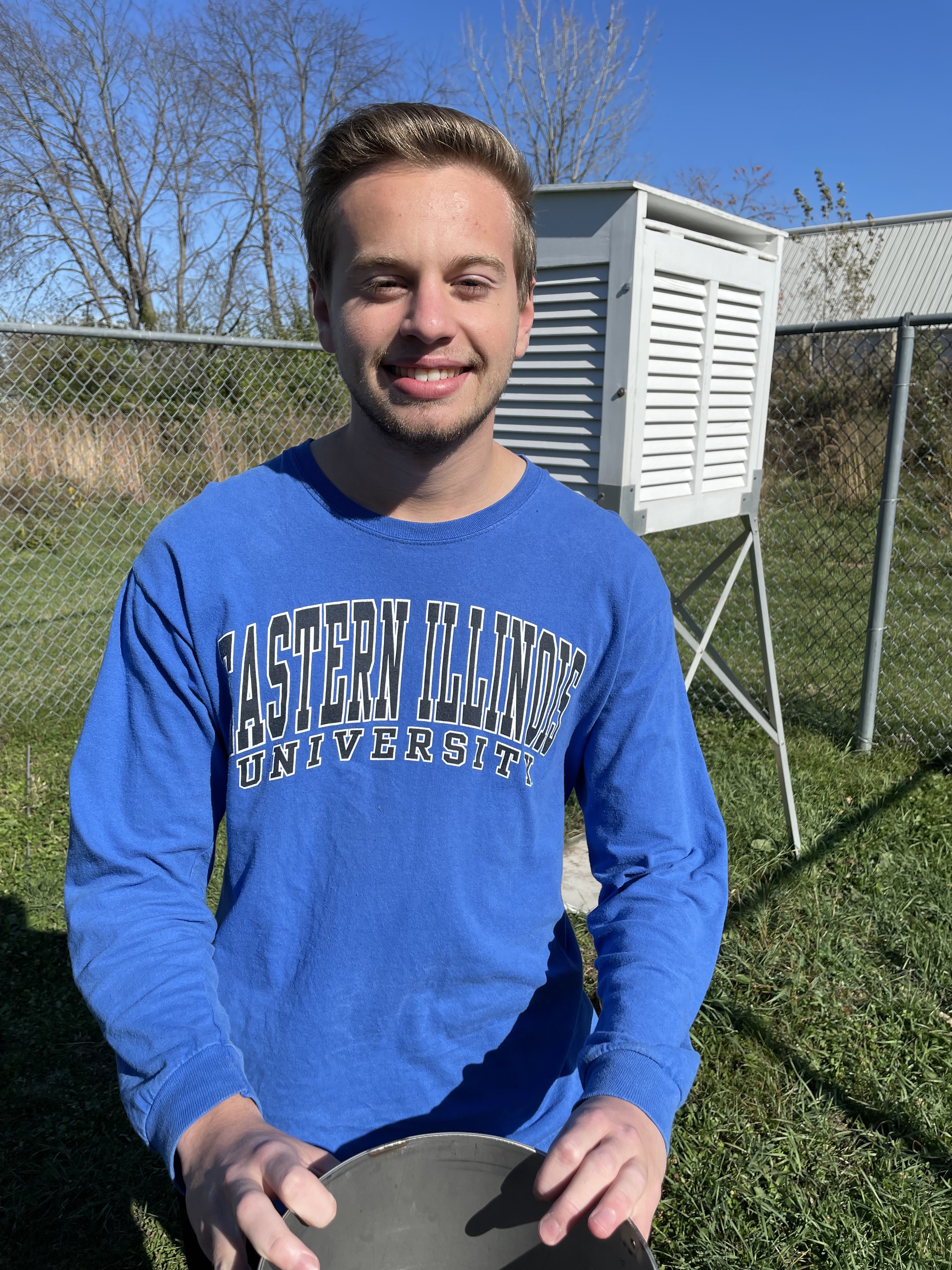
Ryan Lay (’24), EIUWC Undergraduate Director.
As Ryan Lay reached for a treat in the department candy bowl one October day, chairperson Jim Davis instantly reacted, “Students who are not staying for their last semester are banned from taking candy!” Those witnessing the chair’s statement burst into laughter, agreeing that Lay needs to remain on campus. Further persuasive options followed from nearby professors listening in on the scene, “We could change grades to force him to remain for a few more semesters!”
Although he will walk in graduation next May, the department is saddened that Lay’s daily visits, and perfect attendance in classes in the Physical Science Building, is coming to an end. He is not dropping out but wants to work from home, and work at his job to save money for graduate school.
Lay is a young man that is determined to succeed. He is one of the departments most successful students, achieving a 4.0 GPA. A Senior in Geography, Lay is specializing in Environmental Studies with a concentration in Atmospheric Science. Actively applying for graduate schools across the state to study atmospheric science, Lay’s aspiration is to work for National Weather Service.
Lay took the “Broadcast Meteorology Practicum” course after completing “Weather & Climate” during the pandemic. While in the course, he, and other enrolled students, has the option to do research or practice meteorology between the green wall and a camera. Lay nervously gave it a couple of attempts and reverted to his original track, research. I continued to suggest he continue to give “The Wall” a few more tries but he was adamant that research was more to his personality.
He was right! Lay can parse atmospheric concepts down to specifics, always asking about the details of the atmosphere. From our academic conversations, I knew that he had a great talent for researching the atmosphere. I persuaded him to do additional independent studies from the questions he posed during my office hours.
Among the other courses he took in the Department of Geology & Geography, Lay completed research confirming my theory of the “Chain of Lows” concept, and he developed researched concerning the “Differences in GFS forecasted temperatures and observed temperatures,” presented in this issue of Prairie Skies.
Lay presented his “GFS” research for “Media Day” at NWS Lincoln in April and received several positive comments and interests from the few conference attendants, and NWS representatives. His work, in promoting forecast accuracy, continues and he desires to study that area of meteorology in graduate school.
While Ryan is a stellar and model student in the department, faculty and fellow students know the financial requirements to attend university, and graduate school. Lay will return home, continue fulfilling his degree requirements through online courses, and work, fulltime, at Meijer. His decision is sound. It is just the idea that his time with friends and faculty is closing this semester.
Every year, faculty are treated to a few hardworking students. We delight in their devotion to learn, visiting during office hours to ask questions about concepts, offering further insights in ideas that keep professors and scholars considering new developments in science. They are the future.
Four years doesn’t seem long enough to get to know and shape a student’s mind for the future. We know that their foundation for the future is gained from their dedication to want more in science and other fields; to make the world a better place for everyone.
Ryan will carry on what he has studied and learned in his undergraduate career and move on to other scientific adventures. Perhaps he will be a professor at a university after working for NWS, shaping future minds just like him.
When, and if, that time comes, he may just ban his own students from the department’s candy bowl who want to study from home to make money.
Cameron Douglas Craig
Climate Brief
September 2023
In September, temperatures were above average, the normal for this time of year is 69.0°F, but this month we recorded an average of 69.7°F. The maximum temperature, this September, was 94°F on the 4th and the minimum temperature was 44°F on the 14th. Precipitation totaled 1.90” inches, 1.25” inches below the 30-year normal, 3.15”. No records were broken.
Historically, the wettest September on record was set in 1926 with 14.14” of rain. The driest, 0.12”, occurred in 1979. The warmest month on recorded occurred in 1933 at 75.4°F, and the coldest, 59.8°F in 1918.
September’s temperature was near the climatological normal (1991-2020). It was also very dry. The drought level, from the U.S. Drought Monitor for the area, remained abnormally dry (D0) for each week.
Emily Davis
Notes from an Alumna
Weather, Geography, & Agriculture
The weather has a very significant impact on agricultural crops across the United States. “Sun, Sun without the Sun there is no weather Fun” is pivotal for agriculture. All crops need the rain and the sun to grow and bear fruit for harvest. The breadbasket of the United States is very dependent on the location of the mid-latitude cyclones and jet stream.
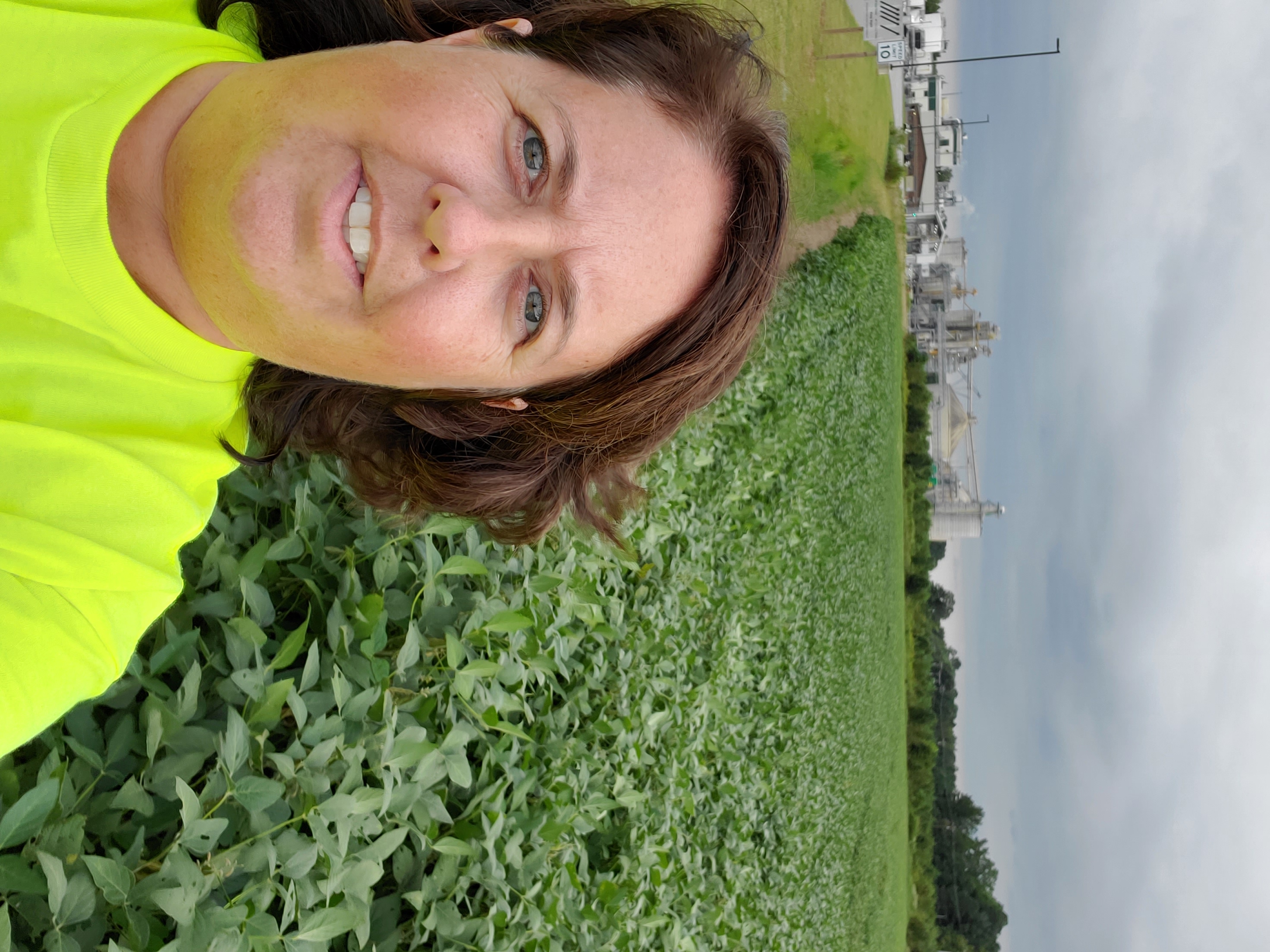
Lahn Henn (‘18) is a Food Safety, Quality & Regulatory Specialist in Fayetteville, N.C. for Cargill.
My location in North Carolina has multiple crops due to the warm coastal air, and the cool mountain air from the north across the Appalachian Mountains. There are crops that are planted early in the spring that will be harvested early or mid-summer for the second crop of the year.
Climate change has shifted weather patterns that affect the growth of agricultural products. 2023 was significantly lower in precipitation in NC, which produced smaller than normal seeds (fruits). Smaller than normal seeds mean it will take more seeds to produce a desired volume of product. Also, smaller seeds mean it will take more to feed animals and humans, thus creating a shortage of product outside of the growing season.
Conversely, an abundance of rain and cool weather will be an optimum growing season, thus creating an abundance of seed. Storage space becomes scarce, and the value of the seed diminishes. It will talk less seed to feed animals and humans. “Bumper” crops are favorable for farmers and consumers because there is more volume available to feed animals and prices drop for consumers.
Weather patterns and climate is key to optimize the agricultural crops.
Lahn Henn (’18)
Notes from an Observer
NWS Celebrates 15 Years and Over 60 Observers
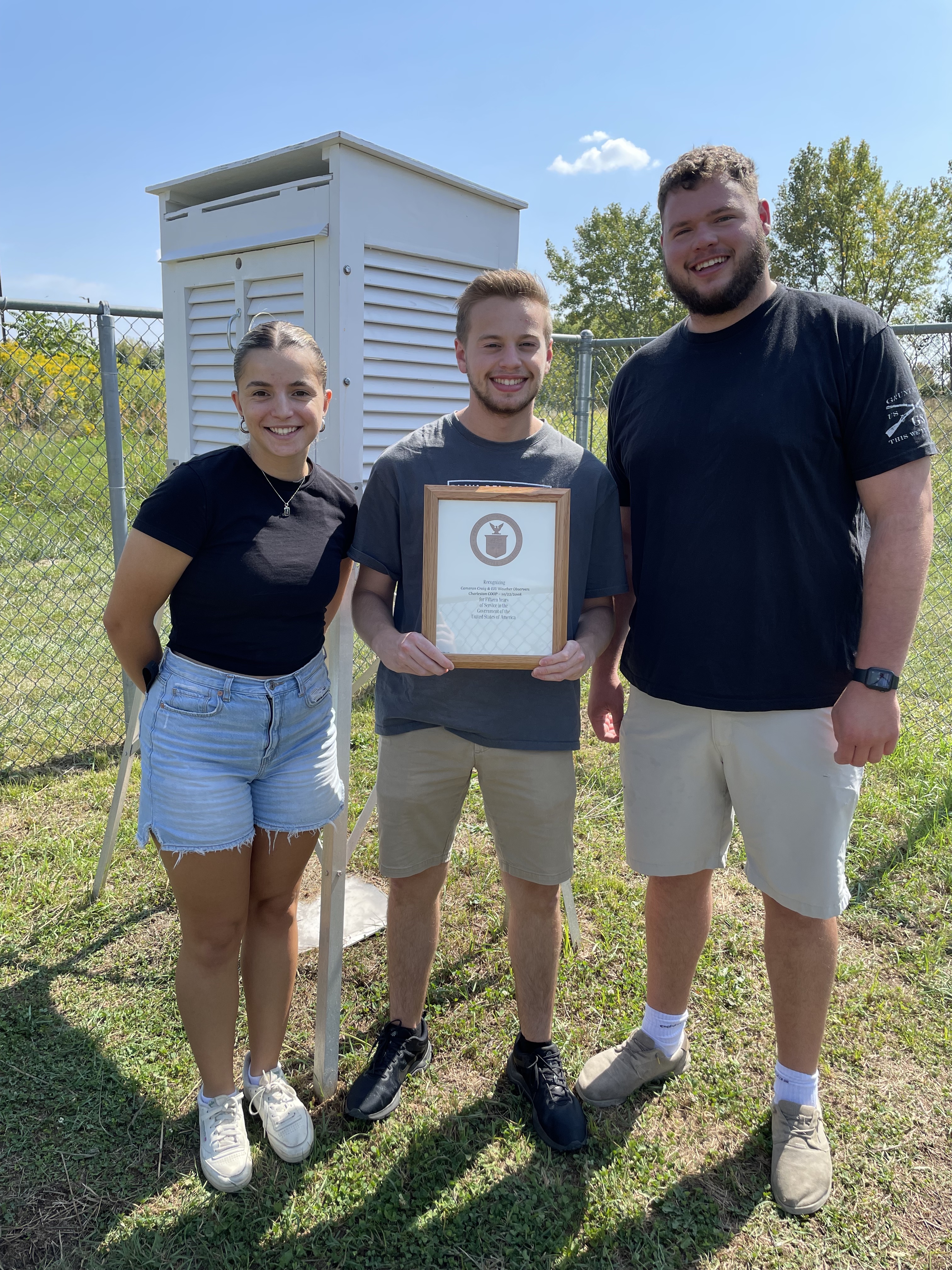
Current EIU Observers, (left to right) Emily Davis, Ryan Lay, and Will Redden, take a moment to appreciate the 15-Year Service Award from NWS Lincoln.
On October 22nd the EIU-NWS Cooperative Weather Observation station celebrated 15 years of service. The student observers were honored by NWS Lincoln for their service of collecting important weather data for the area.
The first observation for Charleston was recorded on January 1, 1880. Considered an historical station, the station was observed by many since the initial observation. One served for 45 years.
Dalias Price (1913-2009), professor emeritus and chair in the Department of Geography-Geology, was one of those observers that recorded data, never missing a day. His observation service awarded him the prestigious Thomas Jefferson and Dick Hagemeyer awards from the National Oceanic Atmospheric Administration in August 2005. Price began his observations for Charleston on April 23, 1960.
The station was transferred to the Department of Geology & Geography on October 22, 2008, when Price, aged 95, was unable to continue his observations. NWS Lincoln worked with EIU to install the station on campus and the first observation was recorded at 6 P.M. by Darren Leeds (’11), former SkyWatch Forecaster, now at WCCU-TV in Champaign, Illinois.
Since the station’s return to campus, over 60 of my student observers have continued Price’s tradition, observing the data in torrential rain, unrelenting snow, bitter cold temperatures, and on holidays. The daily routine provides students with a connection between the classroom and the functions of the atmosphere.
Dalias Price is our inspiration to provide accurate climate data and continue his legacy into the future.
Our student observers (2008-2023): Neil Arthur, Matt Bluhm, Jay Bushen, Leah Bolander (Carter), Brittney Ciciora (Sager), Phillip Collins, Rase Collins, Michael Cornebise, Sam Cornebise*, Cameron Craig, Emily Davis, Heaven Davis (Richey), Jim Davis, John DeMatteo, Joseph Dames, Jessica Dixon, Stephen Elmore, Jeff Fell, Michael Gismondi, Jesse Guinn, Mina Hanalla, Brady Harp, Brian Hartman, Madison Henn, Lahn Henn, McClain Homann, Cameron Hopman, Karl Horn, Colin Houser, Kyler Houser, Will Hurley, Derrick Jackson, Kevin Jeanes, Lauren Jerkovitz, Emily Jestis, Zach Johnson, Johnathan Jones, Rob Kennedy, Jillian Kooistra, Everett Lau, Ryan Lay, Darren Leeds, Caitlin Nordgren (Napoleoni), Jacob Neill*, Jordan Neill*, Phil Norton, Michael Otzwirk, Nick Patrick, Erik Piper, John Pogue, Jakob Reed, Will Redden, Chris Slater, Lacey Spence (Clifton), Noah Spence, John Stimac, and Melissa Watson.
*Denotes students that observed while in middle or high school.
Cameron Douglas Craig
Student Research
Errors in Model Found from Local Observations
You have heard it many times, perhaps you said it yourself, “The weather person doesn’t really know what the weather will be.” Some even say, “The weather person gets paid to get it wrong!” Well, there is an important aspect to this that many do not understand.
Forecasters use numeric prediction data to determine a forecast. These models are the foundation of the meteorologist’s work. They were created from many experts over decades. The basis of these models come from observations, then, put into algorithms to provide users with a “sense” of what is expected. They are not perfect for the simple fact that humans are unable to know the minute functions of the atmosphere. The models, however, continue to get better through continued research. One aspect of that research included one more investigation, the differences between one model and observed data.
During the spring semester of this year, I conducted research with Professor Craig related to the difference between a weather model’s forecasted high temperature and our EIU observation station’s maximum temperature over several 24-hour periods. My research idea came from an observation I made when I was making my own seven-day forecasts for an advanced meteorology class at EIU.
When making forecasts, we used a model known as the Global Forecast System, or commonly referred to as the GFS, the American Model. Weather models are one of the tools that meteorologists use to help make forecasts. When making my own forecasts, I started to notice a trend that our weather observation station here in Charleston always seemed to show a much higher maximum temperature than what the forecasted high was from GFS. It was because of this observation I wanted to do research to see if my observations of the differences were correct.
Our EIU weather station is part of the National Weather Service Cooperative Observer Program (COOP). The first observation was conducted at this site on January 1, 1890, considered one of the original historic reporting sites. Today, observations are done by EIU students every 24 hours at around 6PM. Important climate data is collected, which includes the maximum temperature, minimum temperature, observation (current) temperature, and precipitation data. The maximum temperature is the highest recorded temperature in a 24-hour period, while the minimum temperature is the lowest recorded temperature in a 24-hour period. Temperature data are gathered by reading two different thermometers, manually, by the observers. All data are sent to the National Weather Service, who verifies the data to ensure accuracy.
For my study, I used the 18z (12PM CST in winter, and 1PM CDT, during summer) model run of the GFS. The 18z indicates the approximate time the model is updated for meteorologists to use. For the GFS, an updated model run comes out once every six hours. I used the 18z model to find the forecasted high temperature for the next day. For example, if I were to look for a forecasted high temperature for Wednesday, I would use the 18z model released on Tuesday. This was done from January 15 to April 8, which gave me 84 days of data.
The results from my study were what I suspected, based off our recorded observations at the station. The average maximum temperature was off by a factor of 4.6°F. Out of the 84 days of collected data, 66 days ( 78%) ended up having higher observations temperatures than the model forecasted high temperature. Only nine days (~11%) had a lower maximum observed temperature than what the model forecasted. Five days (~6%) had the same maximum observed temperature than the models forecasted high temperature.
The results of this study show why meteorologists cannot just trust one model to create forecasts. The data one model gives out can be completely wrong. There are several different models that meteorologists use, and using a blend of them can help create a more accurate forecast. Using the models wholeheartedly without regard to the other parameters that are not modeled provides for an error in forecast accuracy. Meteorologists must employ their education of the concepts learned in school to understand other influences on temperatures such as soil moisture, wind speed and direction, cloud cover, and surrounding vegetation.
Professor Craig always instructs us to get outside and observe the environment rather than rely on what is modeled. Our human senses contribute to the accuracy beyond what is modeled. While the models provide a foundation, it is the meteorologist that must use their science to refine a forecast.
Ryan J. Lay
Climate & Art
Five by Six Feet, It Is a Major Feat in Landscape Painting
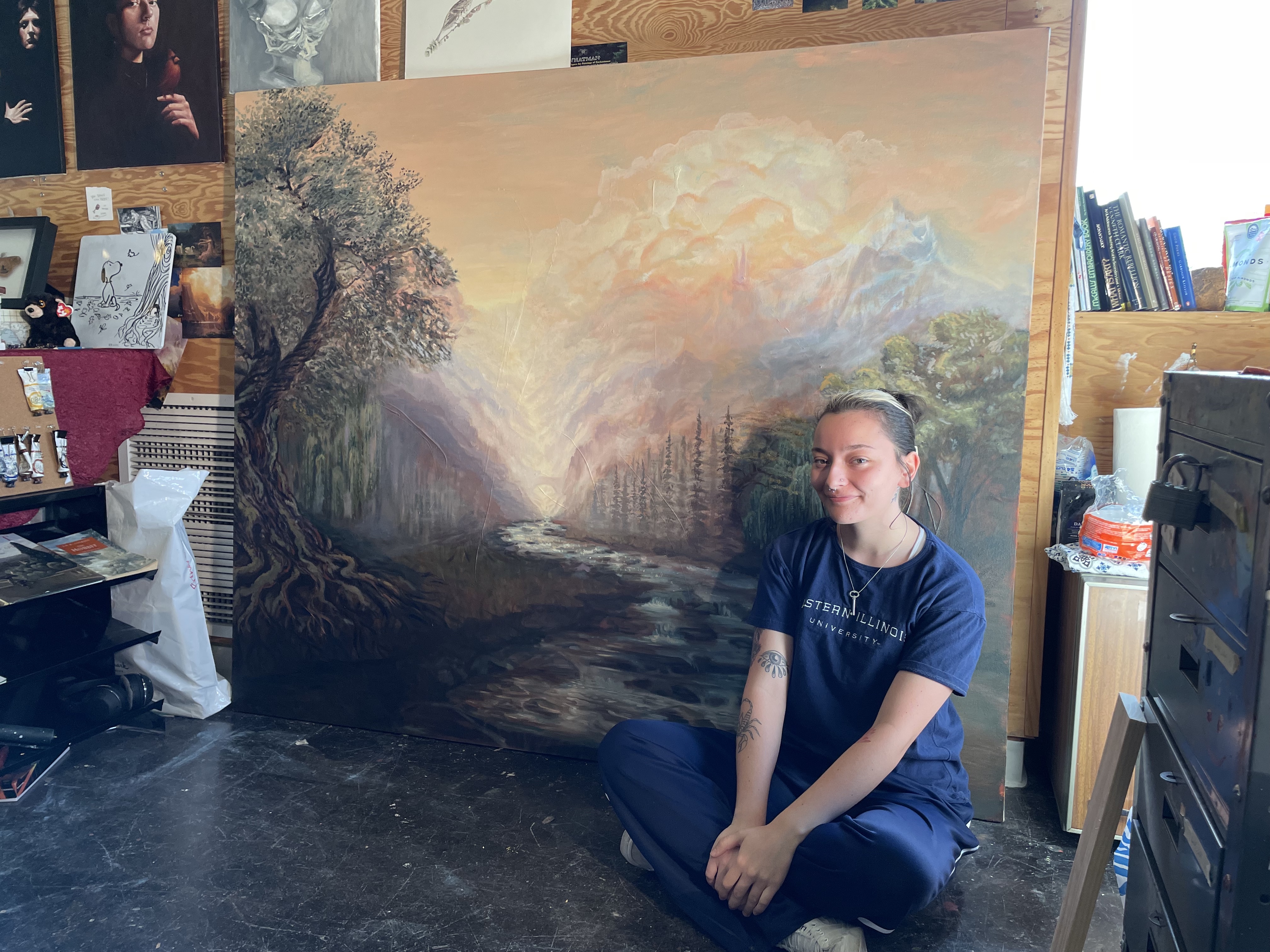
Isabella Gullotta, senior art education major at EIU, sits with her untitled landscape painting.
Getting out of her comfort zone, Isabella Gullotta began her massive project with billowing clouds, massive mountains split by a wildly meandering river, and a sprawling tree.
Gullotta is a senior art education major who usually focuses on traditional realism on a “much smaller scale.” Taking a personal challenge, she began thinking of expanding her abilities on a massive scale.
Isabella began her project on a five by six-foot canvas last spring, spending over 80 hours, since, to convey the western landscape from photographs, and her imagination. “This painting is unfinished,” and without a title.
At one, or two points during her work on the canvas, she was so overwhelmed by it that she just wanted to start over. “I thought I would just paint over it and start again.”
Isabella, who is enrolled in my Senior Seminar class, “Spaceship Earth,” invited Ryan Lay and me to view it in person after showing us photographs of the different sections she had completed. We were amazed by the details. Without having been to the natural landscape of the west, she has captured nature’s beauty. “I am stuck,” she said. “I can understand that, but you will find a way to finish; you can’t stop now!” I suggested that she pause the work and take a trip to a national park to experience her subject firsthand.
“I began to think that I was in over my head,” she said, “but recently my perspective has shifted. I’m starting to see it in a new light, and I’m excited to begin painting again.”
Cameron Douglas Craig
Climate & History
Calamity and Crisis: Witch Hunts of the 17th Century
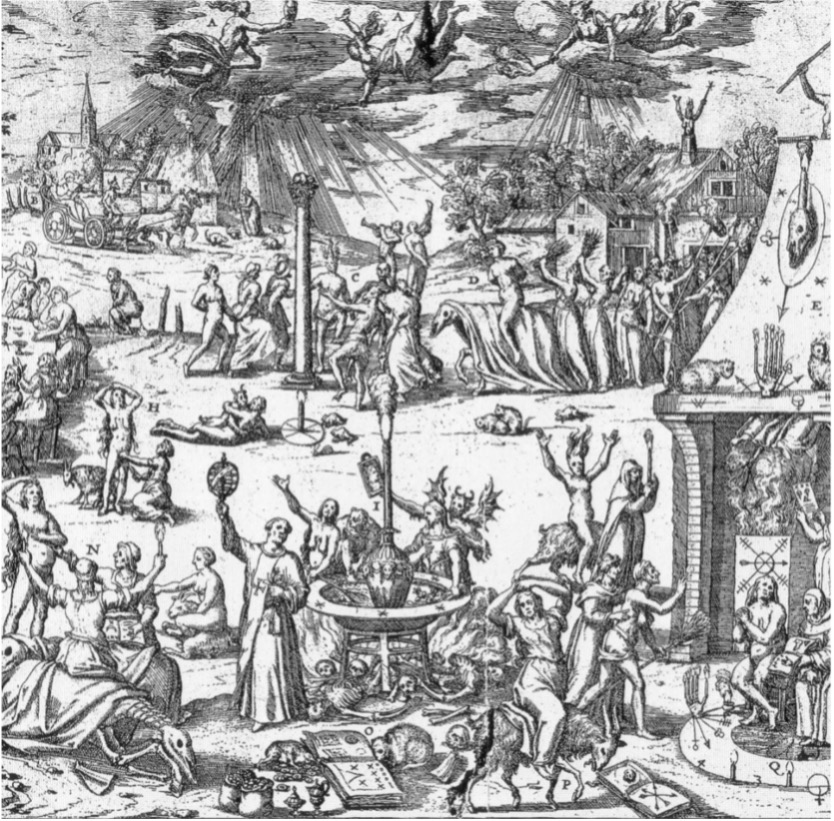
Unknown author - R. Decker, Hexen, 2004, p. 56, Pulbic Domain.
It’s amazing how a singular event can change the course of history.
On February 19, 1600, the largest volcanic eruption ever recorded in South America, Huaynaputina, blasted millions of tons of sulphuric acid into the atmosphere. The volcano littered the surrounding area with nearly seven feet of volcanic rock and ash. The noxious gasses poured out of the geologic feature and were swept to the far corners of the globe. Huaynaputina would continue to erupt periodically for another two weeks before finally coming to rest; never to erupt again.
But this story isn’t just about a volcano in Peru.
It’s a story of a calamity, and a crisis.
A crisis that was unfolding some 6,500 miles away.
* * *
The late 1500’s, early 1600’s marked a tumultuous time in European history. Financial crises were abundant, religious wars were breaking out, and food was becoming scarce. It’s now a time historians call “The General Crisis” because of unsettled political, economic, and religious upheaval. But there’s one more aspect to the time period that could explain why thousands of people were sent to their deaths.
A Change in Climate
While they were unaware of the calamity unfolding in Peru, the residents of now modern-day Germany were about to feel the effects of the volcanic eruption.
The release of sulphuric acid from Huaynaputina is believed to have caused a “volcanic winter” across parts of Western Europe. This gas has a strong cooling effect on the atmosphere because of its ability to block out the sun, and raise Earth’s albedo, essentially reflecting more of the sun’s warmth away from the planet leading to cooler global temperatures.
During this period, Earth entered what’s known as the Little Ice Age.
* * *
Between 1581 and 1632 there were four rounds of witch trials occurring in Holy Roman controlled portions of present-day Southwestern Germany. The Witch Trials of Trier ranged from 1581 - 1587 and killed about 368 people. Johann von Schönenberg was the archbishop of Trier during the period and looked to remove outcasts from the area to prove his religious convictions.
Between 1603 and 1606, Witch Trials resumed, this time in Fulda Germany. A Benedictine monk that had once been exiled by the Lutherans for his policies on cleansing the church from within, had come to power in the region and began investigating witches. During this period more than 200 more people were mostly burned at the stake for their convictions of witchcraft.
By the time we reach 1625, two more sets of witch trials were beginning. One set in Würzburg, another in Bamberg. It was then we began to see the effects of the Little Ice Age sparking these unjust killings.
In 1626, an early frost killed the communion grape harvest. Once word had gotten out about the crop failure, sorcery, and those that claimed they could do such sorcery fell into the crosshairs of the church as the counter-reformation sentiments lingered.
Prince Bishop Philipp Adolf von Ehrenberg ruled over Würzburg during the time of the trials; his sole goal was to create a “godly state”, one that was uniformly Catholic, and witches were not a part of his vision.
The initial suspects were brought in and tortured until they confessed.
But the chaos would only spiral out of control from there.
The first round of suspects, mostly poor women, named more alleged witches. Those would be brought in to be tortured and the cycle continued. But as the trials grew, the wider the accusations were becoming. Soon, in Würzburg, men and women of the wealthy elite were becoming accused. Children and priests were suddenly being convicted as well.
In total, more than 900 people were either executed or died while in custody in just Würzburg, including the Prince Bishop’s own nephew.
By 1630, the Holy Roman Emperor had issued a stop to the persecutions, and by a year later, Ehrenberg was dead. The city had been captured by the Swedish Army, and witch trials were finally over.
Brian Hartman (’17)
Climate Outlook
November 2023
The climate outlook for November appears to remain within the climatological normal. Temperatures for November, using the 30-year average (1991-2020), are 44.6°F, and 3.74” for precipitation. While the outlook indicates equal chances (within the climate average), there will be periods above and below normal conditions. Do not expect conditions to remain “neutral.” There will be moments, as we move into the winter season, that snow may fall in colder periods.
Gavin Garçon
From the Classroom
That Rabbit in the Sky Actually Has a Name
Sometimes each of us look to the skies above and see clouds shaped as rabbits, turtles, cartoon characters, and many other imaginative creatures of our mind’s making. Those shapes actually have names based on their appearance.
Luke Howard (1772-1864) was an English amateur meteorologist who created the nomenclature of clouds. Although, by profession, he was a manufacturing chemist and pharmacist, he won the honor for his work in 1803 after publishing his “Essay on the Modification of Clouds.” Simply using Latin for the appearance of the clouds based on the popularized Linnaean classification system at the time, many people across the world could understand the appearance of clouds because a majority of the world could understand Latin from Roman Catholic Church services.
Jean-Baptist Lamarck, a French meteorologist, lost to Howard because he used the French language, and only useful to those of the French-speaking world. Howard’s original work has been modified over the 200 years since, but the root of their appearance remains the same.
There are four main classes of clouds based on the Latin root for their appearance: stratus, cumulus, cirrus, and clouds producing precipitation, nimbo-/-nimbus.
Stratus or stratiform clouds have a horizontal formation giving them a layered appearance. These clouds are thickest near the surface where lakes, soil, and oceans provide the source of moisture. As these clouds increase in altitude, they get thinner.
Cumulus or cumuliform clouds have a vertical formation giving them a stacked or piled-up appearance. These clouds are biggest near the source of moisture at the surface and get smaller with altitude.
Cirrus clouds at higher altitudes are the only clouds of this class. They have a wispy appearance similar to cotton candy being pulled apart. They are often referred to as angel’s hair or a mare’s tail.
Clouds that produce precipitation have the prefix nimbo- or suffix -nimbus. There are two of these clouds.
Nimbostratus clouds are near the surface with dark, layered appearance. Cumulonimbus clouds are the “Kings of all Clouds.” These clouds are known for producing thunderstorms. They are convective and can span the entire troposphere. If these clouds appear to have rotation, they are called a supercell or mesocyclone, a precursor to producing a tornado.
The altitude of the clouds are as follows: High clouds, 15,000 feet and higher; Middle clouds, 6,500 to 15,000 feet; and Low clouds, below 6,500 feet.
Cameron Douglas Craig
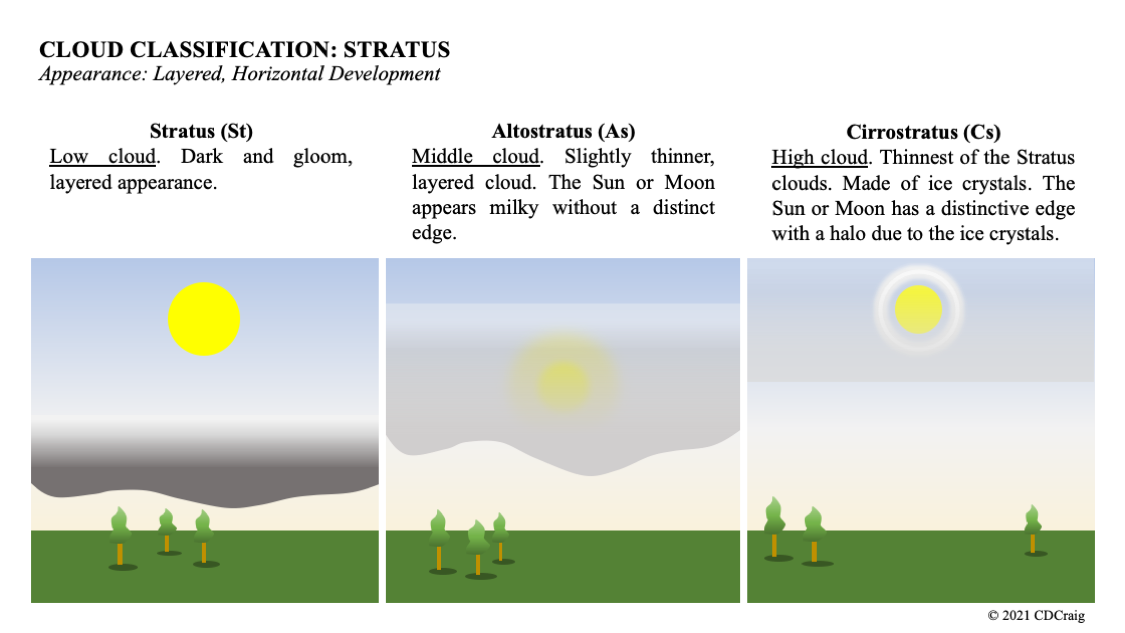
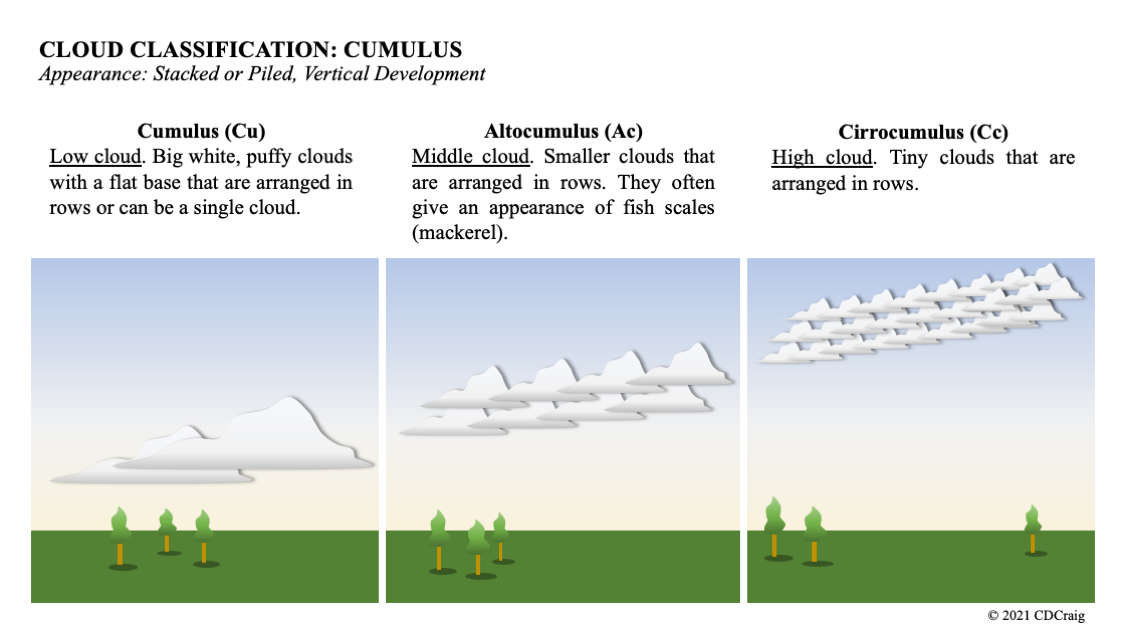
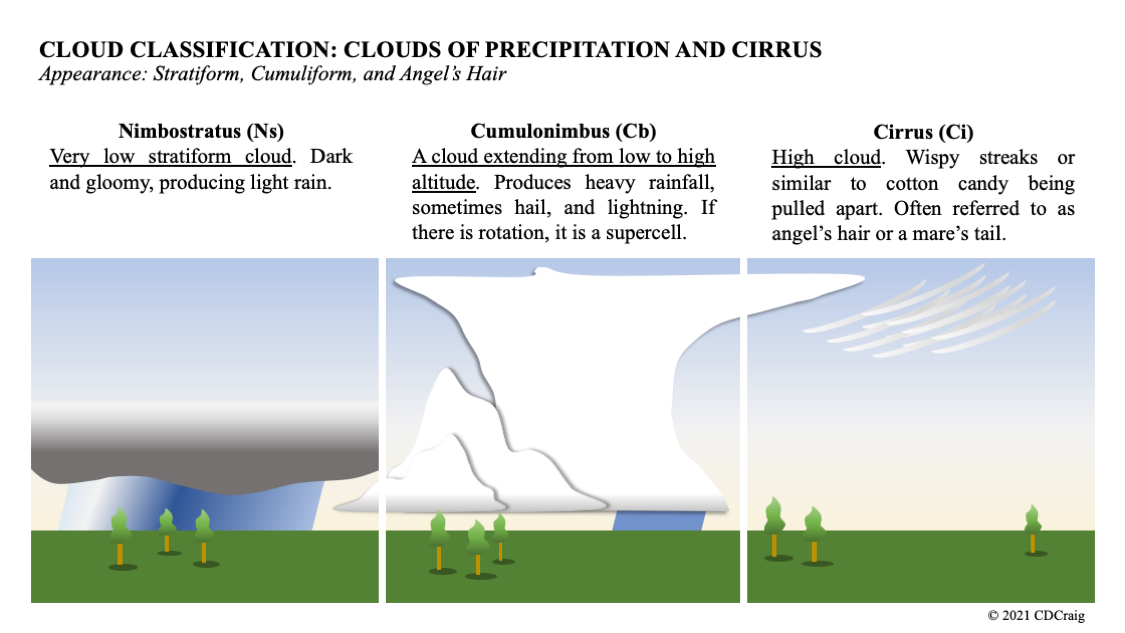
Our Staff
EIU WeatherCenter
WEIUs SkyWatch Team
Cameron Craig, EIUWC Director/WEIU SkyWatch Consultant
Kelly Goodwin, WEIU “News Watch” News Director
Ryan Lay, EIUWC Undergraduate Director
Scott Ealy, SkyWatch Forecaster
Will Redden, SkyWatch Lead Forecaster
Ben Whitney, SkyWatch Forecaster
Emily Davis, SkyWatch Analyst
Gavin Garçon, EIUWC Analyst
Sam Huckstep, EIUWC Analyst
Charlie Stewart, EIUWC Analyst
Isabella Gullotta, Cover Artist
References
November 2023, Vol. 1, Iss. 3
Bressan, David. “Medieval Witch Hunts Influenced by Climate Change.” Scientific American Blog Network, Scientific American, 3 Nov. 2014, https://blogs.scientificamerican.com/history-of-geology/medieval-witch-hunts-influenced-by-climate-change/.
Craig, Cameron D. Without the Sun: Studies in Meteorology & Climatology. 2023.
Glennon, Robert. “John Wesley Powell, Great Explorer of the American West.” Scientific American Blog Network, June 26, 2019. https://blogs.scientificamerican.com/observations/john-wesley-powell-great-explorer-of-the-american-west/.
Guilford, Gwynn. “Why Did Germany Burn so Many Witches? The Brutal Force of Economic Competition.” Quartz, 24 Jan. 2018, https://qz.com/1183992/why-europe-was-overrun-by-witch-hunts-in-early-modern-history.
Legacy.com, and Legacy. “Dalias Price Obituary (2009) - .” Legacy.com, October 6, 2009. https://www.legacy.com/us/obituaries/jg-tc/name/dalias-price-obituary?id=28282644.
Midwest Regional Climate Center, Climate Calendars (1991-2020), 111436, Charleston, Illinois.
National Weather Service. Accessed November 2, 2023. https://www.weather.gov/media/coop/newsletter/22coop-fall-winter.pdf.
NWS/EIU Cooperative Observation Station Data, 111436, Charleston, Illinois.
Oliver, John E. Encyclopedia of World Climatology. Dordrecht, Netherlands: Springer, 2005. Print.
Powell, J.W. (1875). The Exploration of the Colorado River and Its Canyons. New York: Dover Press (reprint).
Randall & Roberts Funeral. “Stanley ‘Red’ H. Robinson Obituary 2019.” Randall & Roberts Funeral Home, April 29, 2022. https://www.randallroberts.com/obituaries/stanley-red-robinson.
Rapley, Robert. “The Characteristics of a Witch Hunt.” In Witch Hunts: From Salem to Guantanamo Bay, 27–31. McGill-Queen’s University Press, 2007. http://www.jstor.org/stable/j.ctt819pr.7.
Rehn, Dana. “Witches in Sixteenth-Century Germany: The Belief in Witches, What They Were Accused of and Why.” Dana K Rehn, 15 Oct. 2022, https://danarehn.com/2022/03/20/witches-in-sixteenth-century-germany/.
U.S. Drought Monitor, National Drought Mitigation Center, University of Nebraska-Lincoln.




